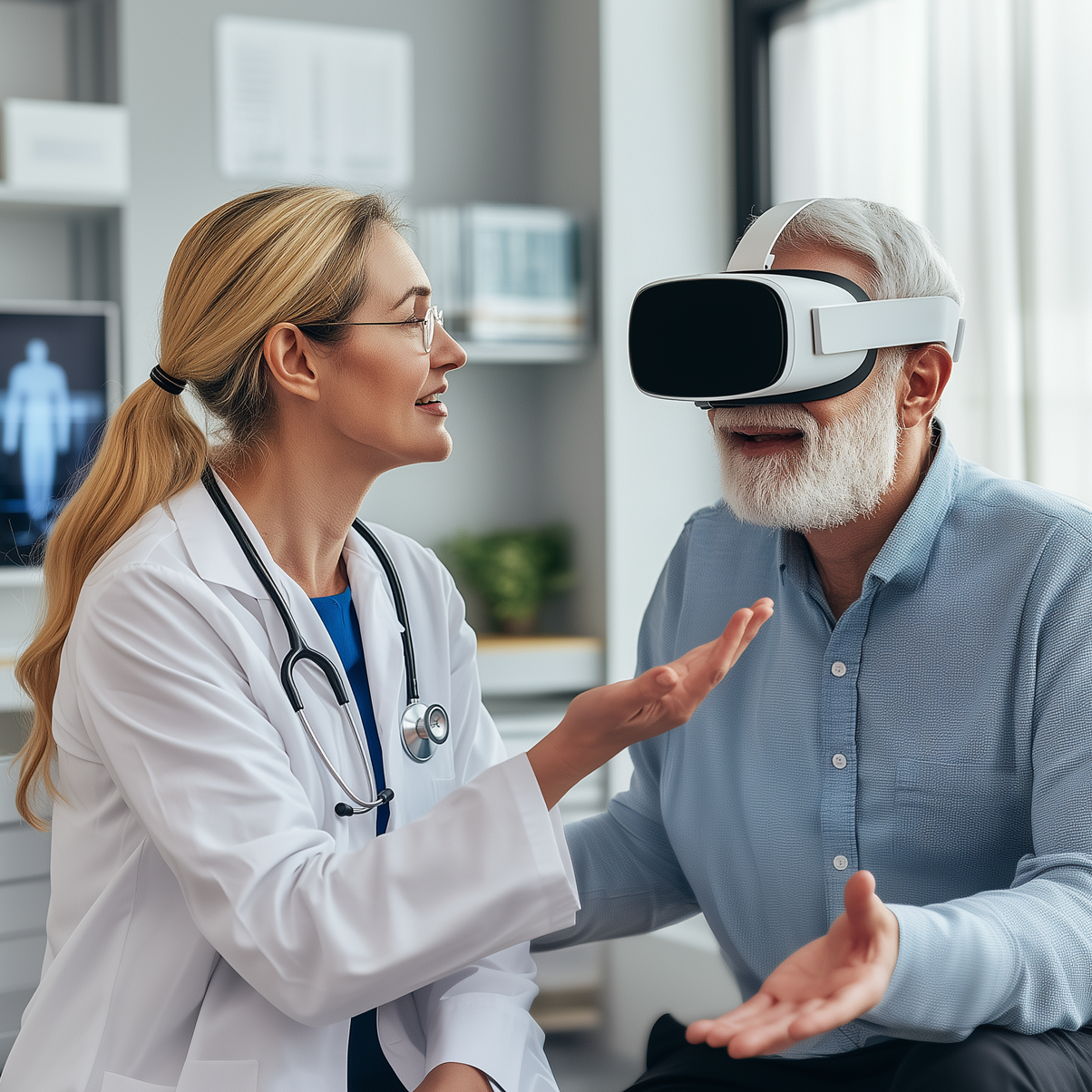
VR Pain Therapy for Patients
Step into Relief
Imagine if managing your chronic pain could feel less like a medical chore and more like a relaxing experience
How to start your
VR Pain Therapy

Talk to Your Doctor
Speak with your physician or pain specialist about CognifiSense VRNT. Bring up that you’re interested in a safe, non-drug therapy for your chronic pain.
Download to give to your doctor
Check Eligibility & Coverage
Your doctor will help determine if VRNT is appropriate for your condition. VRNT is designed for patients 18 and older with a diagnosis of chronic lower back pain - moderate to severe pain lasting longer than 3 months. We can assist in checking your coverage or offer guidance for reimbursement.
Get Your VRNT Home Kit
After approval from your insurance, you will receive the CognifiSense VRNT kit. This includes a comfortable VR headset and a guide. You won’t need to purchase any expensive equipment yourself. The kit is typically mailed to your home (or provided through your clinic) and is ready for a guided setup and onboarding with a care provider.
Putting you in control of
your at-home therapy
Skip the waiting room and start your healing the moment you put on your VR headset. Our therapy is an immersive journey where science meets serenity. Once onboarded, you'll enter a personalized virtual world that adapts to your body, your pain and your pace. Surround yourself with calming visuals, gentle narrations and the comforting rhythm of movement with less and less pain. What once felt impossible – relief, control, confidence – begins to feel within reach. This isn’t just pain management, it’s sensory transformation from the inside out, starting with your mind.
Guided Setup
Your first VRNT session begins with a guided onboarding led by a care provider which can happen in person or over video conference. During this session, you’ll learn about chronic pain, be walked through the setup process to create a visual representation of your pain to upload onto the VR headset for your therapy, and get comfortable using the headset.
Your initial session, guided by a care provider, focuses on learning about your chronic pain, getting familiar with the VR equipment, and setting up your avatar based on your physical profile and pain characteristics. It's natural to feel curious or unsure at first. Most users quickly grow comfortable within minutes.
Therapy Sessions
VRNT is organized into short, focused modules. Each therapy experience is designed to help retrain your brain’s response to pain. Sessions last about 5–15 minutes. Some are calming, like Body Scan, which gently guides attention through your body to release tension. Others are energizing or affirming, like Good Day, helping you visualize a pain-free routine and build a positive mindset. Our therapy protocol has a schedule, but you choose what else you need, day by day.
Avatar Interactions
A key feature of VRNT is interacting with a virtual avatar of yourself. In modules like Mirror, your avatar reflects painless movement, helping reset how your brain processes physical sensations. In motion-based modules like Bend or Lift, you’ll safely rehearse physical actions with visual feedback that reinforces ease and safety, translating into real-world confidence and mobility.
Multi-Sensory Engagement
VR allows us to engage sight, sound and even touch (with gentle controller vibrations). Immersive scenes might include soothing narration, ambient nature sounds and visual effects. By occupying your senses in a positive way, there is less room for pain signals to dominate your awareness.
Progress Tracking
As you complete sessions, VRNT records your activity. You may begin noticing patterns – like which modules bring the most relief, or how your pain levels drop after regular sessions – making progress visible and measurable. Work with your care provider to include pain updates into your current care.
Setup & Onboarding
Your initial session, guided by your practitioner, focuses on getting familiar with the VR equipment and setting up your avatar based on your physical profile and pain characteristics. It's natural to feel curious or unsure at first. Most users quickly grow comfortable within minutes.
Week 1
Within the first week, patients often report feeling calmer and more hopeful. Small changes, such as improved sleep or brief pain reduction immediately following sessions, start to occur. Patients commonly describe VRNT as providing a helpful new "mental tool" for pain management.
Weeks 2–4
With consistent sessions, you may experience longer-lasting reductions in pain as your brain begins to adapt. Daily activities that once triggered pain might start feeling easier and less uncomfortable. Regular practice strengthens your brain's ability to manage pain effectively.
Weeks 5–8
By this stage, noticeable changes typically occur. Patients often reduce reliance on pain medications and regain the confidence to resume activities previously avoided due to pain. You'll likely have identified favorite modules and learned pain-management strategies (e.g., mindfulness or breathing techniques) usable outside VR sessions.
After Your Therapy
Upon finishing the VRNT program, you'll review progress with your healthcare provider. Many patients report significant, sustained improvements in pain and daily functioning. You may continue using VR modules periodically for maintenance or flare-ups, or transition confidently to other self-managed techniques. Your healthcare provider and CognifiSense will remain available to support your ongoing journey.
Therapy from the comfort of your home
on your own schedule
Healing doesn’t have to happen in a clinic. With VRNT, your therapy fits naturally into your life – whether it’s a quiet morning, an afternoon break or part of your bedtime routine. In just minutes a day, you can step into a calming, personalized experience that helps retrain your brain and ease your pain, all without leaving the comfort of your home. You’re in control of where, when and how you heal.
“Technology can be a great tool when it empowers patients and helps change their lives. I think virtual reality for pain management does that! And it is safe and easy to use.”
Dr. Peter Abaci, Boomerang Health
“I’m finally able to enjoy daily activities again without fear of pain, and using VR has added a fun new hobby! My VR therapy has been life-changing.”
Nathan (51)
Is VR chronic pain therapy right for me?
Answer a few questions and find out whether VRNT by CognifiSense™ is right for you.


